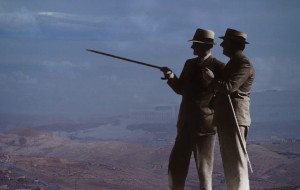Talking With the Past: Architect Erich Mendelsohn on Screen
In March of 1933, German Jewish architect Erich Mendelsohn fled Berlin, having been stripped of his membership in the Architects’ Union and foreseeing even graver consequences from Hitler’s rise to power. He and his wife, Luise, stepped off the train in Amsterdam and bumped into an acquaintance. Surprised at seeing the head of what was then Germany’s largest architectural firm in the Netherlands, the man asked Mendelsohn what he was doing there. The architect took a pencil out of his pocket and held it in the air.
“I’m relocating my office,” he shortly declared.
It wouldn’t be the last time Mendelsohn would start over in a foreign land.
This revealing anecdote is recounted in Incessant Visions, a seductive and complicated new documentary from Israeli director Duki Dror [a short interview with the director follows this review]. The film melds the story of Mendelsohn’s many triumphs, from his rise as an architectural superstar in Berlin and his triumphant designs in the Middle East and America, to bitter disappointments in all the same places. The personal lives—Mendelsohn and his wife are presented here as equals—of these towering twentieth-century figures are explored, too, beyond the blueprints, from friendships with Albert Einstein and Frank Lloyd Wright to Luise’s affair with leftist German poet-politician Ernst Toller.
Dror’s particular brand of storytelling is consonant with the unsettled lives of his subjects. The director employs several devices that at once bring the viewer into the hearts of the peripatetic émigrés, while constantly reminding that what we are watching is quite pointedly the creation of another kind of builder. The film opens on a choppy Berlin square with Dror and his crew asking passersby to help identify the location of an erstwhile building in a photograph they’re holding. The building is long gone, and the name Erich Mendelsohn doesn’t ring many bells. Dror seems to be telling us, from the start, that what follows is the tale of man long forgotten.
The greater part of the story is narrated by voiceovers from Luise’s memoirs, staged as an interview between Dror and her. The effect at first seems corny: why bother with the put-on shtick? We know Luise Mendelsohn isn’t really responding to the questions. But soon we are lulled into the dialogue, listening with wide eyes as the camera sweeps over some of Mendelsohn’s form-breaking buildings, climbing stairs, and exploring long-abandoned interiors.
One such building, Mendelsohn’s first, is Beit Tahara, a ritual cleansing house at the entrance to the Jewish cemetery in his native Olsztyn (then Prussia; now Poland). Designed in the first decade of the last century, the building is ordinary from the exterior: it fits into all the regular right-angled conventions of unexceptional Central European architecture. From the inside, however, there are glimpses of Mediterranean splendor, including a pyramid-shaped roof that noses its way up into the air, decorated with a tile mosaic in once-rich blues. Restoration is currently underway there.
The turning point in Mendelsohn’s career was in large measure due to his wife. Luise was an accomplished cellist, and one of the musicians she frequently played with happened to moonlight as an astrophysicist. The scientist’s brother, a deputy director of the Kaiser Wilhelm Institute for Physical Chemistry and Electrochemistry, was looking for a place to house a solar telescope, which could test out Albert Einstein’s new Theory of Relativity; the Einsteinturm in Potsdam was completed in 1921, propelling Mendelsohn to great fame. The tower is a circular affair, built of brick and covered with white stucco, and it looks to rise out of the ground, pointing skywards with its domed blue roof, which retracts fully to reveal the possibilities of the physical world.
Dror takes us to the tower and shows us its guts. He also uses this moment of triumphant exploration to interview two architectural students from India on pilgrimage to the site. On first consideration, their presence doesn’t add anything. Why include two inconsequential people at the exact moment when Mendelsohn’s genius is first being communicated? But the answer, it seems, lies in Mendelsohn’s own thinking about architecture. Buildings are an evolving dialogue between man and space. Dror’s film, then, is also about exchange — recreated dialogue between Erich and Luise Mendelsohn; between Luise Mendelsohn and Dror; between different generations of architects; between the Mendelsohns, the filmmaker, and the audience. Given the nature of the subject, Incessant Visions is also a conversation between the past, the present, and the future.
Mendelsohn, who went to England from Amsterdam, eventually sailed for Palestine, though not before leaving his mark on the lawn beneath St. George’s Cross. Together with partner Serge Chermayeff, he designed the De La Warr Pavilion — sitting on the lip of the southern coast, it is one of England’s first public Modernist buildings. Its rounded balconies and sleek International Style industrialism stare across the water at Old Europe, reminding the ravaged continent of all it was sacrificing in war, and challenging it to rethink its ideas of modernity.
In Palestine, Mendelsohn designed a slew of projects, from the Weitzmann House, residence of Chaim Weitzmann, first president of Israel, to parts of Hebrew University. Ultimately, though, he left in 1941, when the Nazis were close enough on the African continent to hear them goosestep. Dror explores Mendelsohn’s time in Israel in an interview with a professor from the Technion Israel Institute of Technology. Characteristically, we don’t know who she is (or who any of the experts are, for that matter) until the very end, when, as the credits begin to roll, a snapshot of each interviewee, accompanied by name and title, flashes on screen. What Dror is interested in, besides his subjects, is preventing the viewer from settling too deeply into his chair. This he accomplishes through a combination of withholding information and swift cuts from the lilting voice of Luise and black and white photographs to purposefully opaque present-day interviews.
(Article continued on next page)











